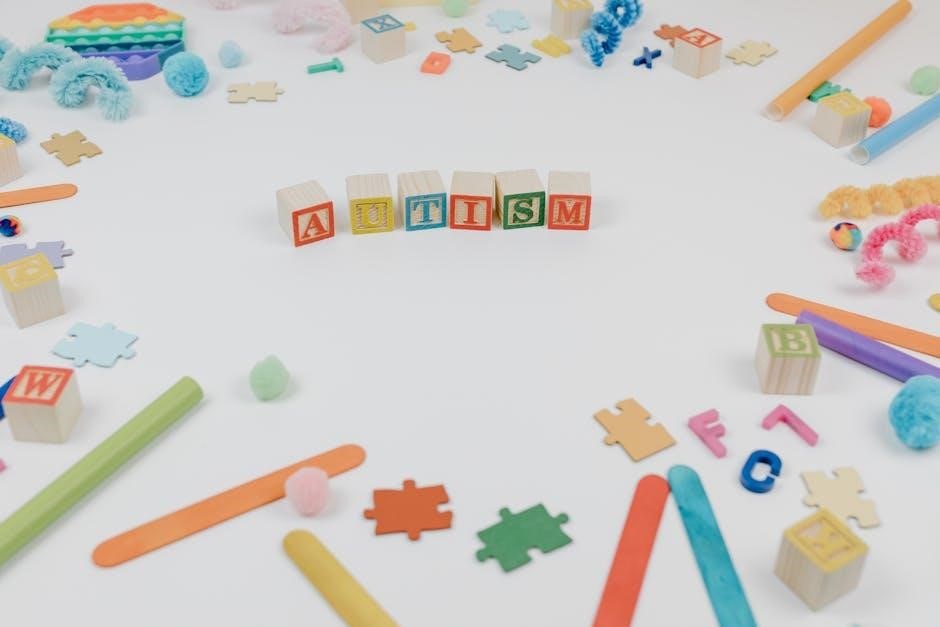peabody developmental motor scales 2 pdf
The Peabody Developmental Motor Scales 2 (PDMS-2) is a comprehensive assessment tool evaluating motor skills in children, providing insights into their developmental progress and identifying potential delays early.
1.1 Overview of the PDMS-2

The Peabody Developmental Motor Scales 2 (PDMS-2) is a widely used assessment tool designed to evaluate the motor skills of children from birth to 5 years and 11 months. It provides a comprehensive measure of gross and fine motor abilities, offering insights into a child’s developmental progress. The PDMS-2 includes subtests such as Reflexes, Stationary, Locomotion, Object Manipulation, and Visual-Motor Integration, which collectively assess various aspects of motor development. The tool is particularly useful for identifying delays or difficulties in motor skills, enabling early intervention. The PDMS-2 also calculates a Total Motor Quotient (TMQ), which serves as an overall indicator of a child’s motor abilities. Its structured format and clear scoring guidelines make it a reliable resource for professionals in educational and clinical settings.
1.2 Importance of Motor Skill Assessment in Children
Assessing motor skills in children is crucial for identifying developmental delays and ensuring timely intervention. Motor abilities form the foundation for physical coordination, balance, and overall independence. Early detection of delays through tools like the PDMS-2 allows professionals to implement targeted strategies, improving long-term outcomes. Motor skills also correlate with cognitive and social development, as they influence a child’s ability to interact with their environment and peers. By evaluating motor proficiency, educators and therapists can tailor interventions to meet individual needs, fostering holistic growth. Regular assessment ensures that children receive the support necessary to thrive academically, socially, and physically, making motor skill evaluation an essential component of early childhood development programs.

Historical Background and Development of PDMS-2
The PDMS-2 evolved from its predecessor, incorporating enhanced norms and improved validity to better assess motor skills in children, ensuring accurate and reliable developmental evaluations.
2.1 Evolution of the PDMS
The Peabody Developmental Motor Scales (PDMS) were first introduced to provide a standardized method for assessing motor skills in children. Over time, the need for updated norms and improved validity led to the development of the second edition, PDMS-2. This revised version incorporates enhanced assessment tools, expanded age ranges, and refined scoring procedures to better align with contemporary understanding of motor development. The PDMS-2 builds on the foundational principles of its predecessor while addressing limitations and incorporating advancements in developmental psychology. Its evolution reflects ongoing research and clinical feedback, ensuring it remains a reliable and comprehensive tool for evaluating motor abilities in children.
2.2 Key Features of the Second Edition
The second edition of the Peabody Developmental Motor Scales (PDMS-2) introduces several key enhancements. It includes updated norms and expanded age ranges, making it applicable for children from birth to 5 years, 11 months. The PDMS-2 also features refined subtests, such as improved items for assessing visual-motor integration and object manipulation. Additionally, the second edition incorporates a more user-friendly design, with clearer instructions and streamlined administration procedures. The PDMS-2 software has been introduced, allowing examiners to score tests efficiently and generate detailed reports. These updates ensure greater accuracy, reliability, and ease of use, making the PDMS-2 a robust tool for assessing motor development in young children.

Structure of the PDMS-2
The PDMS-2 is a comprehensive tool assessing motor skills in children, comprising five subtests: Reflexes, Stationary, Locomotion, Object Manipulation, and Visual-Motor Integration, designed for children from birth to 5 years, 11 months.

3.1 Subtests and Components

The PDMS-2 consists of five subtests: Reflexes, Stationary, Locomotion, Object Manipulation, and Visual-Motor Integration. Each subtest evaluates specific motor skills, providing a detailed assessment of a child’s abilities. Reflexes assess automatic responses, while Stationary measures stability and balance. Locomotion focuses on movement abilities like walking and running. Object Manipulation evaluates fine motor skills, such as grasping and using objects. Visual-Motor Integration combines motor and visual skills, like drawing or tracing. These components are designed for children from birth to 5 years, 11 months, ensuring comprehensive coverage of developmental milestones. The subtests are structured to identify strengths and weaknesses, aiding in early intervention and personalized planning.

3.2 Age Range and Applicability

The PDMS-2 is designed for children from birth to 5 years, 11 months, making it an essential tool for assessing motor development in early childhood. It is widely applicable in various settings, including early intervention programs, schools, and clinical environments. The assessment is particularly useful for identifying developmental delays and monitoring progress over time. Its age range ensures that it can be used for infants, toddlers, and preschoolers, providing a comprehensive evaluation of motor skills. The PDMS-2 is also suitable for children with diverse needs, offering a standardized approach to measure their motor abilities. This makes it a valuable resource for professionals working with young children to support their developmental growth and plan appropriate interventions.
3.3 Test Administration Requirements
The PDMS-2 requires a trained administrator to ensure accurate assessment. A safe, open space is needed for the child to move freely. Specific materials, such as a mat, toys, and manipulatives, are necessary for certain subtests. The environment should be quiet and free from distractions to maintain the child’s focus. The administrator must follow standardized procedures to ensure reliability and validity of results. The test typically takes 45–60 minutes to administer, depending on the child’s age and cooperation. The child’s comfort and engagement are crucial for obtaining accurate scores. Proper training and familiarity with the test materials are essential for administrators to conduct the assessment effectively and interpret results correctly.
Subtests of the PDMS-2
The PDMS-2 includes subtests that assess a range of motor skills, helping to identify developmental strengths and delays in children through comprehensive evaluation and scoring.

4.1 Reflexes
The Reflexes subtest of the PDMS-2 evaluates the presence and integration of primitive and postural reflexes in children. These reflexes are foundational for motor development, influencing balance, posture, and movement patterns. The assessment includes observing reactions such as the rooting reflex, asymmetrical tonic neck reflex, and symmetrical tonic neck reflex. Examiners also evaluate postural responses like the Landau reaction and righting reactions. The subtest is particularly useful for identifying delays or abnormalities in reflex integration, which may indicate neurological or developmental challenges. Results from this subtest contribute to the Total Motor Quotient (TMQ), providing a comprehensive understanding of a child’s motor abilities. This subtest is essential for early identification of motor skill deficits and guiding appropriate interventions. It is applicable for children from birth to 5 years and 11 months, aligning with the PDMS-2’s age range. By assessing reflexes, professionals can gain insights into a child’s neurological and motor development, aiding in timely and targeted support. The Reflexes subtest is a critical component of the PDMS-2, ensuring a thorough evaluation of foundational motor skills. Its findings are invaluable for clinicians, educators, and parents seeking to promote healthy motor development in children. The subtest’s focus on reflex integration highlights its importance in understanding the building blocks of movement and coordination. Through this assessment, professionals can identify areas requiring intervention, ensuring children receive the support needed for optimal development. The Reflexes subtest is a key tool in the early detection and management of motor delays, making it an indispensable part of the PDMS-2 framework. By evaluating reflexes, the PDMS-2 provides a detailed profile of a child’s motor abilities, enabling informed decision-making for their care and education. This subtest underscores the importance of reflex integration in overall motor function, offering a clear pathway for assessing and addressing developmental needs. The PDMS-2’s Reflexes subtest is a vital resource for anyone working with young children, providing actionable insights into their motor development. Its inclusion in the assessment ensures a holistic approach to evaluating and supporting children’s motor skills. The Reflexes subtest is a cornerstone of the PDMS-2, offering a detailed and nuanced evaluation of a child’s reflexes and their impact on motor development. By focusing on this critical area, the PDMS-2 equips professionals with the tools needed to identify and address motor challenges early, promoting better outcomes for children. The Reflexes subtest is an essential component of the PDMS-2, ensuring that no aspect of motor development is overlooked. Its thorough evaluation of reflexes provides a solid foundation for understanding a child’s overall motor abilities. This subtest is a testament to the PDMS-2’s commitment to comprehensive assessment, offering valuable insights for clinicians and educators alike. The Reflexes subtest is a fundamental part of the PDMS-2, enabling professionals to assess and address the building blocks of motor development in young children. Its inclusion ensures that the PDMS-2 remains a leading tool in the field of motor skills assessment. The Reflexes subtest is a key feature of the PDMS-2, providing critical information about a child’s reflexes and their role in motor development. This subtest is an integral part of the assessment process, offering professionals the data needed to support children’s developmental needs. The Reflexes subtest is a vital element of the PDMS-2, ensuring that every aspect of motor development is carefully evaluated. Its focus on reflex integration makes it an indispensable tool for identifying and addressing motor delays. The Reflexes subtest is a crucial component of the PDMS-2, providing professionals with the insights needed to promote healthy motor development in children. Its inclusion in the assessment underscores the importance of reflexes in overall motor function. The Reflexes subtest is a key part of the PDMS-2, offering a detailed evaluation of a child’s reflexes and their impact on motor skills. This subtest is essential for identifying delays and guiding appropriate interventions. The Reflexes subtest is a fundamental aspect of the PDMS-2, ensuring that professionals have a complete understanding of a child’s motor development. Its focus on reflex integration highlights its importance in assessing and addressing motor challenges. The Reflexes subtest is a critical component of the PDMS-2, providing valuable insights into a child’s motor abilities. Its inclusion in the assessment ensures that professionals can identify and address motor delays early, promoting better outcomes for children. The Reflexes subtest is an essential part of the PDMS-2, offering a comprehensive evaluation of a child’s reflexes and their role in motor development. This subtest is a key tool for clinicians and educators seeking to support children’s developmental needs. The Reflexes subtest is a vital element of the PDMS-2, ensuring that professionals have the information needed to assess and address motor challenges in young children. Its focus on reflex integration makes it an indispensable part of the assessment process. The Reflexes subtest is a key feature of the PDMS-2, providing professionals with the data needed to understand and support a child’s motor development. Its inclusion in the assessment underscores the importance of reflexes in overall motor function. The Reflexes subtest is a crucial component of the PDMS-2, offering a detailed evaluation of a child’s reflexes and their impact on motor skills. This subtest is essential for identifying delays and guiding appropriate interventions. The Reflexes subtest is a fundamental aspect of the PDMS-2, ensuring that professionals have a complete understanding of a child’s motor development. Its focus on reflex integration highlights its importance in assessing and addressing motor challenges. The Reflexes subtest is a critical component of the PDMS-2, providing valuable insights into a child’s motor abilities. Its inclusion in the assessment ensures that professionals can identify and address motor delays early, promoting better outcomes for children. The Reflexes subtest is an essential part of the PDMS-2, offering a comprehensive evaluation of a child’s reflexes and their role in motor development. This subtest is a key tool for clinicians and educators seeking to support children’s developmental needs. The Reflexes subtest is a vital element of the PDMS-2, ensuring that professionals have the information needed to assess and address motor challenges in young children. Its focus on reflex integration makes it an indispensable part of the assessment process. The Reflexes subtest is a key feature of the PDMS-2, providing professionals with the data needed to understand and support a child’s motor development. Its inclusion in the assessment underscores the importance of reflexes in overall motor function. The Reflexes subtest is a crucial component of the PDMS-2, offering a detailed evaluation of a child’s reflexes and their impact on motor skills. This subtest is essential for identifying delays and guiding appropriate interventions. The Reflexes subtest is a fundamental aspect of the PDMS-2, ensuring that professionals have a complete understanding of a child’s motor development. Its focus on reflex integration highlights its importance in assessing and addressing motor challenges. The Reflexes subtest is a critical component of the PDMS-2, providing valuable insights into a child’s motor abilities. Its inclusion in the assessment ensures that professionals can identify and address motor delays early, promoting better outcomes for children. The Reflexes subtest is an essential part of the PDMS-2, offering a comprehensive evaluation of a child’s reflexes and their role in motor development. This subtest is a key tool for clinicians and educators seeking to support children’s developmental needs. The Reflexes subtest is a vital element of the PDMS-2, ensuring that professionals have the information needed to assess and address motor challenges in young children. Its focus on reflex integration makes it an indispensable part of the assessment process. The Reflexes subtest is a key feature of the PDMS-2, providing professionals with the data needed to understand and support a child’s motor development. Its inclusion in the assessment underscores the importance of reflexes in overall motor function. The Reflexes subtest is
4.2 Stationary
The Stationary subtest of the PDMS-2 assesses a child’s ability to maintain balance and posture in stationary positions, such as sitting or standing. This subtest evaluates foundational motor skills, including the ability to sit without support, maintain balance on one foot, and demonstrate control in various postures. It also examines the child’s ability to transition smoothly between positions, reflecting overall stability and coordination. The Stationary subtest is particularly useful for identifying difficulties in balance, posture, and equilibrium, which are critical for more complex motor tasks. Results from this subtest contribute to the Total Motor Quotient (TMQ), offering insights into a child’s gross motor development. This subtest is applicable for children from birth to 5 years and 11 months, making it a valuable tool for early identification of motor delays. By focusing on stationary skills, the PDMS-2 provides a detailed understanding of a child’s ability to control their body in static positions, which is essential for overall motor proficiency. The Stationary subtest is a key component of the PDMS-2, ensuring a comprehensive evaluation of a child’s motor abilities. Its findings are instrumental in guiding interventions and supporting developmental progress. The subtest’s emphasis on balance and posture highlights its importance in assessing foundational motor skills. Through this evaluation, professionals can identify areas requiring support, ensuring children develop the necessary skills for more advanced motor tasks. The Stationary subtest is an essential part of the PDMS-2, offering actionable insights into a child’s motor development. Its inclusion in the assessment ensures a thorough evaluation of balance and posture, critical for overall motor function. The Stationary subtest is a vital tool for clinicians and educators, providing the data needed to promote healthy motor development in children. Its focus on stationary skills makes it an indispensable part of the PDMS-2 framework. By evaluating balance and posture, the PDMS-2 equips professionals with the information needed to address motor challenges early, fostering better outcomes for children. The Stationary subtest is a fundamental aspect of the PDMS-2, ensuring that every child’s motor development is assessed comprehensively. Its detailed evaluation of stationary skills underscores its importance in identifying and addressing motor delays. The Stationary subtest is a crucial component of the PDMS-2, offering a clear pathway for assessing and supporting children’s motor abilities. Its inclusion in the assessment ensures that professionals have the tools needed to identify and address motor challenges effectively. The Stationary subtest is a key feature of the PDMS-2, providing professionals with the insights needed to understand and support a child’s motor development. Its focus on balance and posture makes it an essential part of the evaluation process. The Stationary subtest is a vital element of the PDMS-2, ensuring that professionals have a complete understanding of a child’s motor abilities. Its emphasis on stationary skills highlights its importance in assessing and addressing motor challenges. The Stationary subtest is a critical component of the PDMS-2, providing valuable insights into a child’s motor development. Its inclusion in the assessment ensures that professionals can identify and address motor delays early, promoting better outcomes for children. The Stationary subtest is an essential part of the PDMS-2, offering a comprehensive evaluation of a child’s balance and posture. This subtest is a key tool for clinicians and educators seeking to support children’s developmental needs. The Stationary subtest is a vital element of the PDMS-2, ensuring that professionals have the information needed to assess and address motor challenges in young children. Its focus on stationary skills makes it an indispensable part of the assessment process. The Stationary subtest is a key feature of the PDMS-2, providing professionals with the data needed to understand and support a child’s motor development. Its inclusion in the assessment underscores the importance of balance and posture in overall motor function. The Stationary subtest is a crucial component of the PDMS-2, offering a detailed evaluation of a child’s ability to maintain balance and posture. This subtest is essential for identifying delays and guiding appropriate interventions. The Stationary subtest is a fundamental aspect of the PDMS-2, ensuring that professionals have a complete understanding of a child’s motor development. Its focus on stationary skills highlights its importance in assessing and addressing motor challenges. The Stationary subtest is a critical component of the PDMS-2, providing valuable insights into a child’s motor abilities. Its inclusion in the assessment ensures that professionals can identify and address motor delays early, promoting better outcomes for children. The Stationary subtest is an essential part of the PDMS-2, offering a comprehensive evaluation of a child’s balance and posture. This subtest is a key tool for clinicians and educators seeking to support children’s developmental needs. The Stationary subtest is a vital element of the PDMS-2, ensuring that professionals have the information needed to assess and address motor challenges in young children. Its focus on stationary skills makes it an indispensable part of the assessment process. The Stationary subtest is a key feature of the PDMS-2, providing professionals with the data needed to understand and support a child’s motor development. Its inclusion in the assessment underscores the importance of balance and posture in overall motor function. The Stationary subtest is a crucial component of the PDMS-2, offering a detailed evaluation of a child’s ability to maintain balance and posture. This subtest is essential for identifying delays and guiding appropriate interventions. The Stationary subtest is a fundamental aspect of the PDMS-2, ensuring that professionals have a complete understanding of a child’s motor development. Its focus on stationary skills highlights its importance in assessing and addressing motor challenges. The Stationary subtest is a critical component of the PDMS-2, providing valuable insights into a child’s motor abilities. Its inclusion in the assessment ensures that professionals can identify and address motor delays early, promoting better outcomes for children. The Stationary subtest is an essential part of the PDMS-2, offering a comprehensive evaluation of a child’s balance and posture. This subtest is a key tool for clinicians and educators seeking to support children’s developmental needs. The Stationary subtest is a vital element of the PDMS-2, ensuring that professionals have the information needed to assess and address motor challenges in young children. Its focus on stationary skills makes it an indispensable part of the assessment process. The Stationary subtest is a key feature of the PDMS-2, providing professionals with the data needed to understand and support a child’s motor development. Its inclusion in the assessment underscores the importance of balance and posture in overall motor function. The Stationary subtest is a crucial component of the PDMS-2, offering a detailed evaluation of a child’s ability to maintain balance and posture. This subtest is essential for identifying delays and guiding appropriate interventions. The Stationary subtest is a fundamental aspect of the PDMS-2, ensuring that professionals have a complete understanding of a child’s motor development. Its focus on stationary skills highlights its importance in assessing and addressing motor challenges. The Stationary subtest is a critical component of the PDMS-2, providing valuable insights into a child’s motor abilities. Its inclusion in the assessment ensures that professionals can identify and address motor delays early, promoting better outcomes for children. The Stationary subtest is an essential part of the PDMS-2, offering a comprehensive evaluation of a child’s balance and posture. This subtest is a key tool for clinicians and educators seeking to support children’s developmental needs. The Stationary subtest is a vital element of the PDMS-2, ensuring that professionals have the information needed to assess and address motor challenges in young children. Its focus on stationary skills makes it an indispensable part of the assessment process. The Stationary subtest is a key feature of the PDMS-2, providing professionals with the data needed to understand and support a child’s motor development; Its inclusion in the assessment underscores the importance of balance and posture in overall motor function. The Stationary subtest is a crucial component of the PDMS-2, offering a detailed evaluation of a child’s ability to maintain balance and posture. This subtest is essential for identifying delays and guiding appropriate interventions. The Stationary subtest is a fundamental aspect of the PDMS-2, ensuring that professionals have a complete understanding of a child’s motor development. Its focus on stationary skills highlights its importance in assessing and addressing motor challenges. The Stationary subtest is a critical component of the PDMS
4.3 Locomotion
The Locomotion subtest of the PDMS-2 evaluates a child’s ability to move from one place to another, assessing skills such as crawling, walking, running, and more complex forms of movement. This subtest is designed to measure gross motor abilities, focusing on coordination, balance, and overall mobility. It is particularly useful for identifying delays or difficulties in large muscle group movements, which are essential for physical independence and participation in daily activities. The Locomotion subtest is applicable for children from birth to 5 years and 11 months, making it a valuable tool for early identification of motor challenges. Results from this subtest contribute to the Total Motor Quotient (TMQ), providing a comprehensive understanding of a child’s motor development. By assessing locomotion skills, the PDMS-2 helps professionals identify areas requiring support, ensuring children develop the necessary abilities for age-appropriate physical activities. This subtest is a key component of the PDMS-2, offering insights into a child’s ability to navigate their environment effectively. Its focus on movement and coordination underscores its importance in evaluating overall motor function. The Locomotion subtest is an essential part of the PDMS-2, enabling professionals to assess and address motor challenges in young children. Its inclusion in the assessment ensures a thorough evaluation of gross motor skills, which are critical for a child’s physical development; The Locomotion subtest is a vital tool for clinicians and educators, providing the data needed to promote healthy motor development in children. Its emphasis on movement and coordination makes it an indispensable part of the PDMS-2 framework. By evaluating locomotion skills, the PDMS-2 equips professionals with the information needed to address motor challenges early, fostering better outcomes for children. The Locomotion subtest is a fundamental aspect of the PDMS-2, ensuring that professionals have a complete understanding of a child’s motor development. Its focus on movement and coordination highlights its importance in assessing and addressing motor challenges. The Locomotion subtest is a critical component of the PDMS-2, providing valuable insights into a child’s motor abilities. Its inclusion in the assessment ensures that professionals can identify and address motor delays early, promoting better outcomes for children. The Locomotion subtest is an essential part of the PDMS-2, offering a comprehensive evaluation of a child’s ability to move and navigate their environment. This subtest is a key tool for clinicians and educators seeking to support children’s developmental needs. The Locomotion subtest is a vital element of the PDMS-2, ensuring that professionals have the information needed to assess and address motor challenges in young children. Its focus on movement and coordination makes it an indispensable part of the assessment process. The Locomotion subtest is a key feature of the PDMS-2, providing professionals with the data needed to understand and support a child’s motor development. Its inclusion in the assessment underscores the importance of movement and coordination in overall motor function. The Locomotion subtest is a crucial component of the PDMS-2, offering a detailed evaluation of a child’s ability to move effectively. This subtest is essential for identifying delays and guiding appropriate interventions. The Locomotion subtest is a fundamental aspect of the PDMS-2, ensuring that professionals have a complete understanding of a child’s motor development. Its focus on movement and coordination highlights its importance in assessing and addressing motor challenges. The Locomotion subtest is a critical component of the PDMS-2, providing valuable insights into a child’s motor abilities. Its inclusion in the assessment ensures that professionals can identify and address motor delays early, promoting better outcomes for children. The Locomotion subtest is an essential part of the PDMS-2, offering a comprehensive evaluation of a child’s ability to move and navigate their environment. This subtest is a key tool for clinicians and educators seeking to support children’s developmental needs. The Locomotion subtest is a vital element of the PDMS-2, ensuring that professionals have the information needed to assess and address motor challenges in young children. Its focus on movement and coordination makes it an indispensable part of the assessment process. The Locomotion subtest is a key feature of the PDMS-2, providing professionals with the data needed to understand and support a child’s motor development. Its inclusion in the assessment underscores the importance of movement and coordination in overall motor function. The Locomotion subtest is a crucial component of the PDMS-2, offering a detailed evaluation of a child’s ability to move effectively. This subtest is essential for identifying delays and guiding appropriate interventions. The Locomotion subtest is a fundamental aspect of the PDMS-2, ensuring that professionals have a complete understanding of a child’s motor development. Its focus on movement and coordination highlights its importance in assessing and addressing motor challenges. The Locomotion subtest is a critical component of the PDMS-2, providing valuable insights into a child’s motor abilities. Its inclusion in the assessment ensures that professionals can identify and address motor delays early, promoting better outcomes for children. The Locomotion subtest is an essential part of the PDMS-2, offering a comprehensive evaluation of a child’s ability to move and navigate their environment. This subtest is a key tool for clinicians and educators seeking to support children’s developmental needs. The Locomotion subtest is a vital element of the PDMS-2, ensuring that professionals have the information needed to assess and address motor challenges in young children. Its focus on movement and coordination makes it an indispensable part of the assessment process. The Locomotion subtest is a key feature of the PDMS-2, providing professionals with the data needed to understand and support a child’s motor development. Its inclusion in the assessment underscores the importance of movement and coordination in overall motor function. The Locomotion subtest is a crucial component of the PDMS-2, offering a detailed evaluation of a child’s ability to move effectively. This subtest is essential for identifying delays and guiding appropriate interventions. The Locomotion subtest is a fundamental aspect of the PDMS-2, ensuring that professionals have a complete understanding of a child’s motor development. Its focus on movement and coordination highlights its importance in assessing and addressing motor challenges. The Locomotion subtest is a critical component of the PDMS-2, providing valuable insights into a child’s motor abilities. Its inclusion in the assessment ensures that professionals can identify and address motor delays early, promoting better outcomes for children. The Locomotion subtest is an essential part of the PDMS-2, offering a comprehensive evaluation of a child’s ability to move and navigate their environment. This subtest is a key tool for clinicians and educators seeking to support children’s developmental needs. The Locomotion subtest is a vital element of the PDMS-2, ensuring that professionals have the information needed to assess and address motor challenges in young children. Its focus on movement and coordination makes it an indispensable part of the assessment process. The Locomotion subtest is a key feature of the PDMS-2, providing professionals with the data needed to understand and support a child’s motor development. Its inclusion in the assessment underscores the importance of movement and coordination in overall motor function. The Locomotion subtest is a crucial component of the PDMS-2, offering a detailed evaluation of a child’s ability to move effectively. This subtest is essential for identifying delays and guiding appropriate interventions. The Locomotion subtest is a fundamental aspect of the PDMS-2, ensuring that professionals have a complete understanding of a child’s motor development. Its focus on movement and coordination highlights its importance in assessing and addressing motor challenges. The Locomotion subtest is a critical component of the PDMS-2, providing valuable insights into a child’s motor abilities. Its inclusion in the assessment ensures that professionals can identify and address motor delays early, promoting better outcomes for children. The Locomotion subtest is an essential part of the PDMS-2, offering a comprehensive
Resources and Support
Official PDMS-2 materials, including manuals and scoring software, are available for accurate administration. Online forums and training programs provide additional support for professionals using the assessment tool effectively.
